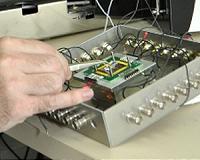 |
Bochum, Germany (SPX) Mar 01, 2011 Bochum physicists are constructing 0-dimensional systems Through his participation, the research team from Bochum, Duisburg-Essen, and Hamburg now has succeeded in an energy-state occupancy readout of those artificial atoms - using common interfaces to classic computers. This is a big step towards the application of such systems. They report about their findings in Nature Communications.
One million instead of individual atoms In this case, quantum mechanics are helpful: For standard electron densities in semiconductors, the wavelength of electrons (and holes) is several tens of nanometres (nm), which means a distance of 100 atoms. It therefore is not necessary to isolate or insert individual atoms. It suffices to define areas that expand in each direction by about 100 atoms, thus comprising around 1003 = one million atoms. 'But even that is not all that simple, because today's high-level integration controls a resolution that reaches only down to around 50nm,' explained Prof. Wieck.
Trick: Stacking oranges on mandarins The first layer or oranges (InAs) is arranged so that the oranges on top of the mandarins (GaAs) are 'squeezed', which results in a 'strained' layer. The second orange (InAs) layer must be strained as well, but if several of such layers are placed on top of one another, the orange system 'forgets' its underlying mandarin layer order. The strain 'relaxes', which means it causes defects and gaps and piles up the oranges into individual heaps. Such InAs heaps - InAs quantum dots or 'QD' (derived from the English term 'Quantum Dots') - therefore grow in a self-organised way. They are several 10nm wide and around 5nm high, and therefore are ideally suited for the quantum mechanical charge carrier inclusion. It is just large enough to fit into a wavelength of electrons and/or electron holes. The QDs force the electrons into quantified energies by means of which they can be used as 'artificial atoms' for information processing purposes.
10 million times smaller than a hamburger 'This may be very elegant, but requires an extensive measuring operation with specialised lasers, detectors and spectrometers', explained Wieck. During the actual work, the researchers adopted quite a different approach: They prepared the QDs on (close to) a conducting layer of electrons and only measured the electric resistance of this layer, which changes with the QD's electron occupation. 'Consequently, this gives us direct electronic access to the occupied states in the QDs and these are capable of being read with the common interfaces of classic computers.'
Share This Article With Planet Earth
Related Links Ruhr-University Bochum Computer Chip Architecture, Technology and Manufacture Nano Technology News From SpaceMart.com
 Manipulating Molecules For A New Breed Of Electronics
Manipulating Molecules For A New Breed Of ElectronicsTempe AZ (SPX) Feb 23, 2011 In research appearing in the journal Nature Nanotechnology, Nongjian "NJ" Tao, a researcher at the Biodesign Institute at Arizona State University, has demonstrated a clever way of controlling electrical conductance of a single molecule, by exploiting the molecule's mechanical properties. Such control may eventually play a role in the design of ultra-tiny electrical gadgets, created to per ... read more |
|
| The content herein, unless otherwise known to be public domain, are Copyright 1995-2010 - SpaceDaily. AFP and UPI Wire Stories are copyright Agence France-Presse and United Press International. ESA Portal Reports are copyright European Space Agency. All NASA sourced material is public domain. Additional copyrights may apply in whole or part to other bona fide parties. Advertising does not imply endorsement,agreement or approval of any opinions, statements or information provided by SpaceDaily on any Web page published or hosted by SpaceDaily. Privacy Statement |